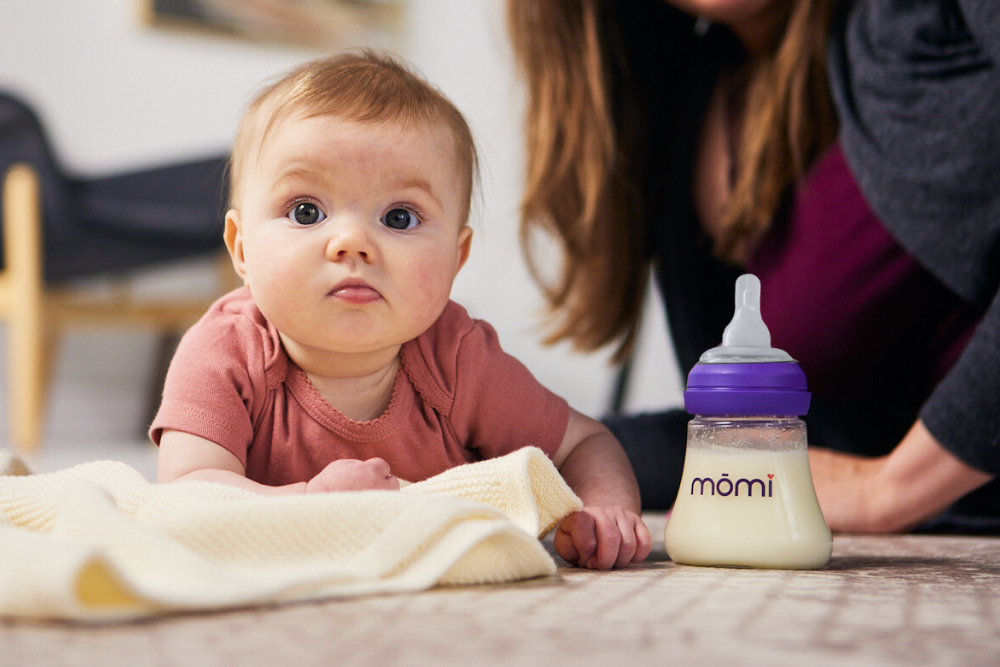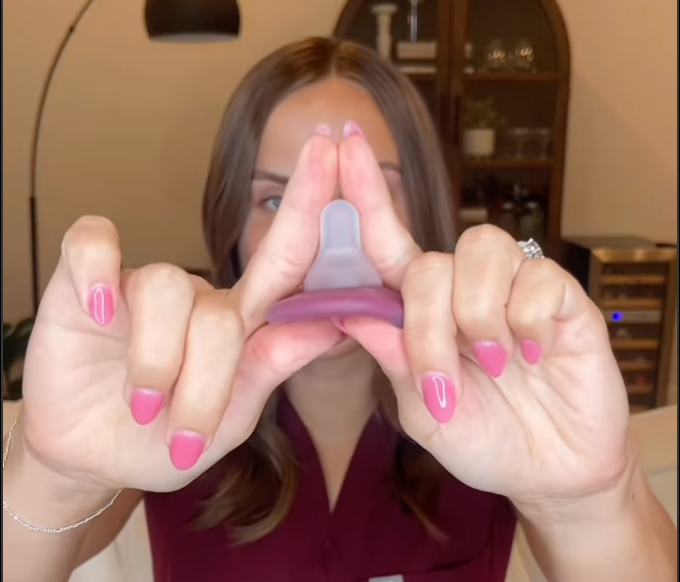From cleaning newborn bottles to bottle sterilization, this guide covers everything you need to know about washing baby bottles and cleaning breast pump parts with expert-approved tips.
Before Washing Baby Bottles: Step-by-Step Preparation
Start by dissembling all parts of the baby bottle.
Remove the bottle nipple from the bottle collar, take apart any caps, valves, or additional pieces until all bottle parts are separated.
Germs can easily become trapped in the small spaces between bottle parts. Separate the bottle nipple from the bottle collar before washing. Disassemble any additional pieces (including bottle caps) so that the entire surface area of each bottle piece can be cleaned.
Rinse all bottle parts and baby feeding items under running water, or put them in a clean basin to soak with a small amount of dish soap.
Ideally, bottle rinsing should happen right after every feed. Rinsing your baby bottle parts in a timely manner prevents formula or breast milk from drying in the bottle and building up residue on the sides.
You can also keep a basin of warm soapy water to dunk all used bottle parts into after every feed and then clean all bottle parts at the end of the day. Remember to wash these bottle parts in freshwater after soaking and to disinfect or sanitize the basin surfaces regularly as well. If you are leaving your rinsed bottles out on the counter, make sure to clearly label the dirty bottle parts so you don’t mix them up with the cleaned, air-drying bottles.
How to Safely Clean Baby Bottles in the Dishwasher
Check to ensure that the baby bottle or infant feeding item is dishwasher safe.
There isn’t an industry standard for the term “dishwasher safe.” However, in general, it means that an item can withstand high heat, dishwasher sprays, and detergent without the integrity of the item being compromised.
Look for a symbol or label indicating “dishwasher safe” on the bottom surface of your baby bottle or of the outer packaging. Importantly, even if a plastic item is labeled dishwasher safe, you should place it on the top rack of the dishwasher to prevent it from melting during the bottle cleaning process.
Loose bottle parts should be placed in a closed-top basket or in your silverware basket so that they do not fall into the dishwasher filter.
Run the dishwasher on hot water and with a heated drying cycle.
The heat from the drying cycle will further sanitize your baby bottle parts and ensure that you’ve cleaned and sanitized your baby’s bottles correctly.
How to Wash Baby Bottles Correctly by Hand
Scrub the baby bottles and infant feeding parts with hot, soapy water and a bottle-cleaning brush used exclusively for cleaning baby bottle parts.
The key to properly cleaning baby bottles is to avoid cross-contamination of germs. This means using freshwater for each stage of soaking and cleaning. Use a designated clean scrub brush that doesn’t have food particles on it.
When cleaning newborn and infant bottles by hand, remember to get soapy water into the small nipple hole / duct and to reach into the small corners and areas where germs could be trapped.
After washing baby bottles by hand, rinse them with clean water and place them on a clean, unused dish towel to air dry thoroughly.
How to Sanitize Baby Bottles and Baby Feeding Items
Thankfully, having readily available clean water nowadays in many parts of the world means that cleaning newborn and infant bottles is less of a concern than it has been in earlier decades. However, if your baby has a weakened immune system – or if you are in an area where the water cleanliness is not guaranteed – sanitizing baby bottles might be a good idea.
Do I always need to sanitize baby bottles?
The CDC recommends that “sanitizing baby bottles is particularly important when your baby is younger than 3 months, was born prematurely, or has a weakened immune system. Daily sanitizing of feeding items may not be necessary for older, healthy babies if those items are cleaned carefully after each use.”
How to Sanitize Baby Bottles with Boiling Water
-
Put all of the deconstructed parts of a clean, washed baby bottle in a pot and cover with water.
-
Heat the pot until water comes to a boil.
-
Boil the baby bottle parts for 5 minutes (or to the manufacturer’s recommended time).
-
Use tongs to carefully remove the sanitized baby bottle parts.
- Allow the baby bottles to air dry on a clean, unused dish towel.
How to Sanitize Baby Bottles with Steam
-
Make sure your microwave is clean.
-
Fill clean, washed bottles halfway with water.
-
Microwave on high for one or two minutes.
-
Carefully remove the extremely hot bottles from the microwave using oven mitts, and dump the hot water out.
- Allow the baby bottles to air dry on a clean, unused dish towel.
You can also purchase microwavable steamer bags or a baby bottle steamer, both of which are designed specifically for bottle sterilization.
How to Properly Store Clean Baby Bottles and Feeding Items
Dedicate a washable, covered bin to store your clean baby bottles and infant feeding items. This bin should be cleaned by the dishwasher or washed by hand periodically.
It’s a good idea to keep your baby bottle bin covered to keep out dust and bugs and to store this bin in a cabinet or drawer.
Remember to allow all baby bottle parts to dry completely before screwing on lids or replacing nipples. Trapped moisture can turn into mold and become an “incubator” for germs.
How to Clean Breast Pump Parts Correctly
The directions for safely washing breast pump parts are nearly identical to the directions for safely washing baby bottles and baby feeding items – except for a few changes.
Directions for Properly Cleaning Breast Pump Parts
-
Disassemble all breast pump parts.
-
Rinse out all breast pump parts that come into contact with breast milk under warm water.
-
Wash these same breast pump parts either by hand with warm soapy water and a dedicated brush for infant cleaning products only, or place breast pump parts in the upper rack of the dishwasher.
-
Let breast pump parts air dry on a clean, unused dish towel.
- Store all pump parts in a dedicated covered bin, away from dirt, dust, and other sources of cross-contamination.
FAQ on Cleaning Baby Bottle Parts and Baby Feeding Items Correctly
Is there an age where I can stop sanitizing baby bottles daily?
Yes. According to the CDC, if your baby is older than 3 months and is healthy, you do not need to sanitize daily. However, you should still clean baby bottles carefully and promptly after each feeding.
Do I need to use boiled, bottled, or purified water when washing baby bottles?
No, so long as you have access to safe drinking water, you do not need to use boiled, bottled or purified water to clean baby bottles or baby feeding items.
What’s the safest way to dry bottles after cleaning?
The CDC recommends air-drying as the safest way to dry bottles after washing because using a dish towel to rub items might transfer germs. For air-drying, the CDC recommends that you place the bottle parts and brush, as well as washbasin, on a clean dish towel or paper towel in an area shielded from dirt or dust.
FAQ on Cleaning Breast Pump Parts Correctly
What breast pump parts need to be cleaned after every use?
Any bottles, valves, breast shields, or flanges that come into contact with breast milk should be cleaned with the above directions after every use.
Do I need to wash my breast pump tubing as well?
The U.S. Food and Drug Administration (FDA) advises on how to clean breast pump tubing:
“It is not necessary to clean breast pump tubing unless it comes in contact with breast milk. If you wash your tubing, make sure you hang it to air dry before attaching it to your breast pump. If small water drops (condensation) appear in the tubing after you have pumped, turn the pump on for a few minutes until the tubing is dry.”
My parts can’t fully air dry in between use, is this a problem?
So long as your parts aren’t trapping moisture in-between uses, it is okay if all the moisture has not evaporated in-between pumping sessions. Wash your hands, and shake excess water off before pumping. Do not wipe with a cloth or paper towel because this can introduce germs.
I don’t have a sanitary place at work to let my pump parts air dry, what should I do?
Many working moms face the challenge of storing pumping parts properly when at work because they most often need to utilize a shared kitchen space. If you do not have a safe space to let your pump parts air dry in between uses, you can place clean pump parts into a large sealed plastic bag and store this in the refrigerator.
The cool temperature will keep any germs at bay and limit the growth of bacteria. Use a bag that can be either washed regularly or disposed of so that you aren’t placing clean parts in a dirty bag.





